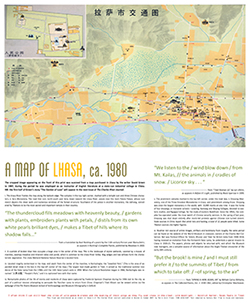
click to download PDF |
[The following text is taken from a flyer distributed as an insert in this our inaugural issue of The Charles River Journal. The informational prose was written by me, and the excerpted material was selected by me. Free to reuse and repurpose. To download a PDF of the original insert, right-click on the graphic shown at right. - ZB]
The cropped image appearing on the front of this print was scanned from a map purchased in Lhasa by the writer David Green in 1987, during the period he was employed as an instructor of English literature at a state-run industrial college in China. NB: the first half of Green's story "The Garden of Love" will appear in the next issue of The Charles River Journal.
i. The Lhasa River frames the map along the bottom edge. The complex in the top right corner, marked with a temple icon and three Chinese characters, is Sera Monastery. The road that runs north-south past Sera, down toward the Lhasa River, passes near the main Potala Palace, whose icon sketch depicts the sheer walls and numerous windows of the famed structure. Southeast of the palace is another monastery, the Jokhang, considered by Tibetans to be the most sacred and important temple in their country.
"The thundercloud fills meadows with heavenly beauty, / gardens with plants, embroiders plants with petals, / distils from its own white pearls brilliant dyes, / makes a Tibet of hills where its
shadow falls . . . " - from a translation by Basil Bunting of a poem by the 11th-century Persian poet Manuchehri, as appears in Bunting's Complete Poems, published by Bloodaxe in 2000. ii. A scumble of broken blue lines occupies a large area in the center of the map. This is the landscape of alpine wetlands, covered by a mosaic of marshes, swampy meadow and itinerant lakes and ponds, which is common to the Lhasa River Valley. Bog sedges and low willows form the characteristic vegetation. The Lhalu Wetland National Nature Reserve is located here.
iii. Located roughly centermost in the map, and south from the center of the marshes, is Norbulingka, the "Jewelled Park." (This is the area of expanded detail show in the box in the top-left corner of the map.) The largest man-made garden in Tibet, it served as the traditional summer residence of the Dalai Lama from the 1780s until the 14th Dalai Lama's exile in 1959. When the Cultural Revolution began in 1966, Norbulingka was renamed "人民公园," "People's Park," and it is captioned here with that name.
iv. Remarkable photos of the life of monks and residents of Lhasa were captured by Frederick Spencer Chapman during his 1936 visit to the city. as part of a political mission attempting to persuade the Panchen Lama to return from China. Chapman's Tibet Album can be viewed online via the webpage of the Pitt Rivers Museum School of Anthropology and Museum Ethnography in Oxford.
“We listen to the / wind blow down / from Mt. Kailas, // the animals in / cradles of snow. / Licorice sky . . . " - from “Tibet Woman (2)” by Lyn Lifshin, as appears in Before It's Light, published by Black Sparrow in 1999. v. The prominent complex marked in the top left corner, under the inset box, is Drepung Monastery, one of the Three Greatest Monasteries in Lhasa, and preeminent among those. Drepung was once the largest monastery in the world, with 10,000 monks at one time. It was the home of four drasangs, or monastic schools-Loseling, Gomang and Deyang Colleges, devoted to exoteric studies, and Ngagpa College, for the study of esoteric Buddhism. Since the 1950s, the complex has operated under the close watch of Chinese security services. In the spring of last year, Drepung was shut down entirely after monk-led protests against Chinese rule turned violent. State sources in China report that amid riots and looting, a total of 22 people were killed. Some Tibetan sources cite higher figures.
vi. Another rich source of online images, artifacts and testimony from roughly the same period can be found at the website of the World Museum in Liverpool, owners of the Charles Bell Collection. Bell was Political Officer for Sikkim, Bhutan and Tibet for British India from 1908-1918; having received an invitation from the thirteenth Dalai Lama, he undertook a special mission to Lhasa in 1920-21. The papers, photos and objects he returned with, and which the Museum now manager, are a valuable source of information about the Anglo-Tibetan encounter of the early 20th century.
“But the brook! is mine / and I must still prefer it / to the summits of Tibet / from which to take off: / –of spring, to the air" - from “Spring Is Here Again, Sir” by William Carlos Williams, as appears in The Collected Poems, Vol. 2: 1939-1962, edited by Christopher MacGowan. This flyer was distributed as an insert in Issue 1 of The Charles River Journal , published in Boston in Summer 2009 by Pen & Anvil Press, ISBN 1548-3487. Text compiled by Zachary Bos. Free to reuse and repurpose.
“I often think I can still hear the cries of wild geese and cranes and the beating of their wings as they fly over Lhasa in the clear, cold moonlight." - Heinrich Harrer, Seven Years in Tibet
|